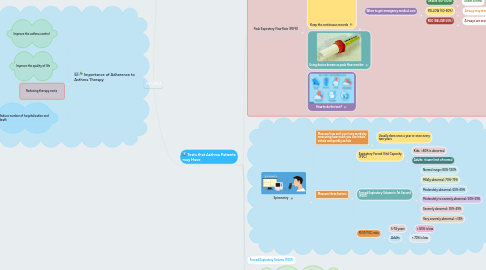
1. Importance of Adherence to Asthma Therapy
1.1. Improve the asthma control
1.2. Improve the quality of life
1.3. Reducing therapy costs
1.4. Reduce number of hospitalization and death
2. Implications of Non-Adherence
2.1. Worsen asthma control
2.2. Decrease quality of life
2.3. Increase cost
2.4. Increased hospitalization rates
2.5. Reduced lung functions
2.6. Increase episodes of asthma attack, shortness of breath and etc
3. Tests that Asthma Patients may Have
3.1. Peak Expiratory Flow Rate (PEFR)
3.1.1. Measure the amount of air you can exhale in one fast breath
3.1.1.1. Can detect small changes in the large airways before you start to wheeze
3.1.1.1.1. At least once a day at same time, usually before taking medications - personal best value and normal value will be determined
3.1.2. Keep the continuous records
3.1.2.1. When to stop or add medicine as directed by your healthcare provider
3.1.2.2. How well an asthma treatment plan is working
3.1.2.3. When to get emergency medical care
3.1.2.3.1. GREEN (80-100%)
3.1.2.3.2. YELLOW (50-80%)
3.1.2.3.3. RED (BELOW 50%)
3.1.3. Using device known as peak flow monitor
3.1.4. How to do the test?
3.2. Spirometry
3.2.1. Measure how well your lung works by measuring how much you can inhale, exhale and quickly exhale
3.2.1.1. Usually done once a year or once every two years
3.2.2. Measure three factors
3.2.2.1. Expiratory Forced Vital Capacity (FVC)
3.2.2.1.1. Kids: <80% is abnormal
3.2.2.1.2. Adults: <lower limit of normal
3.2.2.2. Forced Expiratory Volume in 1st Second (FEV1)
3.2.2.2.1. Normal range: 80%-120%
3.2.2.2.2. Mildly abnormal: 70%-79%
3.2.2.2.3. Moderately abnormal: 60%-69%
3.2.2.2.4. Moderately to severely abnormal: 50%-59%
3.2.2.2.5. Severely abnormal: 35%-49%
3.2.2.2.6. Very severely abnormal: <35%
3.2.2.3. FEV1/FVC ratio
3.2.2.3.1. 5-18 years
3.2.2.3.2. Adults
3.3. Forced Expiratory Volume (FEV1)
3.4. Laboratory values
3.4.1. PEFR
3.4.2. Blood pressure, Respiratory rate
3.4.3. Forced Vital Capacity (FVC)
3.5. Asthma control test
3.5.1. Help to determine whether the asthma symptoms is well controlled or not
3.5.2. Use score systems
